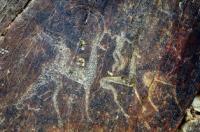Вы здесь
Petroglyphs of Aksakalatasay.

Petroglyph Site Tour in Uzbekistan.
“People usually feel funny, smile and laugh when I tell them
about my strong belief in the very existence of prehistoric
advanced technology and great civilizations of wilier races.
I just can't wait to see their faces at time the truth is revealed”
Toba Beta.
Trip to petroglyphs Uzbekistan.
Aksakalatasay Valley is 30km to the north-east of Navoi in the Novbahor District of the Navoi Region, on the southern slopes of the Karatau Mountains, 10-12km east of the Sarmishsay Valley. Aksakalatasay Gorge is over 35km long and Aksakalata village is in the middle of it.
A stream of the same name, flowing at the bottom of the valley is one of the right tributaries of the Zarafshan River. Rock outcroppings in Aksakalatasay mainly consist of fine-grained sandstone, granodiorite, limestone and shale.
The rock is strongly affected by atmospheric factors and tectonic processes, resulting in overhangs, shelters and many boulders of various shapes and sizes. A total of 500 images were registered in Aksakalatsay Gorge both on rocks in the open and in shelters, along the two banks as well as on riverside rocks of the lateral tributaries.
A concentration of petroglyphs and drawings were painted on protected rock surfaces with mineral paint. Several groups of rock art sites are isolated. The first site with petroglyphs is located 2 - 3km north of Aksakalata.
More than 100 images dated to different periods right up to modern times were found. Most drawings (mainly deer and goats) are rather homogeneous and can be dated from the IIIrd century BC to the Ist century AD.
Some red drawings are located on an almost vertical rock (2m high, 3m wide, and 1m deep at the entrance) under an overhang, 2.5 - 3m above the mouth of the spring, facing east. No remains of occupation layers were found.
The walls of the shelter are rough and covered with calc-sinter. In its middle, most images are on either side of a crack. In several other places, very unclear paint spots still remain. The images do not overlap but in some cases they may touch.
A series of them form a prominent panel with related motifs. Eight palm prints and sketchy spirals with seven coils are quite visible. The images are 10 - 20cm long and the spiral over 35cm. Their ancient age, probably Neolithic, is obvious: they are overlaid with a crust of calc-sinter and petroglyphs of later periods have modern-day inscriptions painted on top of them.
A second rock art site in Aksakalatasay is 4 - 5km to the north-east of the first one in the middle of the valley. More than 500 petroglyphs of different periods including 6 boulders with red drawings were found. The petroglyphs are covered with desert varnish.
Their carving technique is rough, the marks left by the tool used are uneven and shallow; the images are 5cm to 1.2m wide. Rock paintings are heavily eroded by the wind. The Aksakalatasay petroglyphs are registered as a site of local importance, but the boundaries and protection zone of the site have not yet been determined nor protection provided.
Authority:
Muhiddin Khujanazarov.
Photos by
Alexander Petrov.







